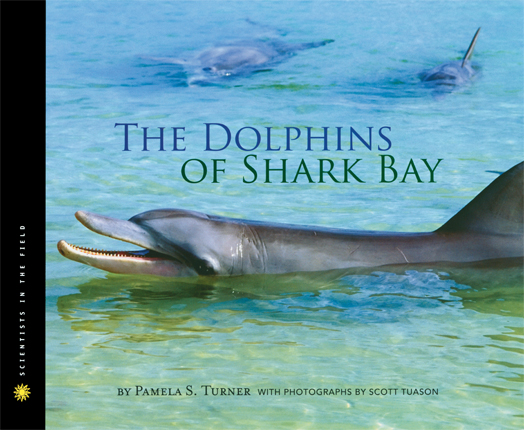Full Text Reviews: Booklist - 11/01/2013 The Shark Bay Dolphin Project, under the direction of biologist Janet Mann, is the subject of this latest book in the acclaimed Scientists in the Field series. Dolphins’ uncommonly developed intelligence is undisputed fact, but Mann’s field research is unique in that most other observations occur in captivity. Studying dolphins in their natural habitat off the coast of western Australia, Mann’s team has witnessed them using tools, socializing their young, developing hunting strategies, and forming alliances. Her work goes far beyond proving the fact that dolphins are smart; she seeks to discover the reasons for the development of their higher brain functions. Mann not only provides excellent examples of scientific thinking through the formulation and testing of hypotheses, she also serves as an authentic and engaging role model for girls considering careers in science. Using the team’s intimate knowledge of the wild cetaceans, Turner treats the dolphins as lively characters unto themselves in this affecting and vividly photographed work of nonfiction. - Copyright 2013 Booklist. School Library Journal - 11/01/2013 Gr 5–9—Turner's newest offering tops even her stellar The Frog Scientist (2009) and Project Seahorse (2010, both Houghton Mifflin) as she delineates and explains the research being conducted on a unique clan of dolphins at Shark Bay, Australia. The lucid text reveals the complexities of this cetacean society, first as a whole, then by delving into smaller sets of male groupings and female/calf relationships. Researcher Janet Mason and her team arrived in Shark Bay in 1988, following in the footsteps of Richard Connor and Rachel Smolker, whose initial studies had attracted Mason to this special environment. Turner joined the team in their research expeditions and carefully documents such topics as foraging and hunting techniques, maternal care, social interactions (including sexual behaviors), echolocation, intelligence, and tool use. Individual dolphins get a lot of attention as well-Nicky, a bad mother; Puck, a terrific one; Reggae, a beach hunter; Dodger, an expert sponger, among others. Clear color photos accompany the text, along with two pages of "More About Dolphins," a brief list of books/films (all adult), and a quick update on some of the humans and dolphins mentioned in the book. Readers come away with an amazing, if sometimes blurred vision of a culture different from their own, in an alien environment with language, mores, and behaviors that they can only partially understand, and a crystal clear perspective of scientists trying to interpret what they see. A challenging, attractive eye-opener.—Patricia Manning, formerly at Eastchester Public Library, NY - Copyright 2013 Publishers Weekly, Library Journal and/or School Library Journal used with permission. Bulletin for the Center... - 12/01/2013 “She’s self-centered, her kid needs foster care, and her own family won’t have anything to do with her.” No, she’s not the mother in a YA novel, but one of the dolphins being studied in this captivating new outing in the venerable Scientists in the Field series. Author Turner joins Janet Mann and her colleagues on the west coast of Australia, where they’ve been studying this regional population of dolphins since the 1980s. Four decades of experience means the researchers know the dolphins’ personalities and their histories, so there’s an irresistible touch of dolphin soap opera to the book. There’s no shortage of fascinating science in the breezy and engaging narrative, though, as the team explores these dolphins’ innovative use of tools (raking the sea floor with sponges to chase hidden fish out) and how this knowledge seems to be transmitted (from mother to child, but female dolphins pick up the practice more often than male). The social dynamics of dolphin life and the evolutionary advantages and disadvantages of intelligence (notable in comparing the dolphins to their local predator the tiger shark) are also examined. While being deliberately anti-mythical about dolphins (“Dolphins aren’t noble elves in wetsuits”), the book conveys the wonder of learning more about the intricacy of another species, and readers will be won over by both the dolphins and the science. Photographs are sometimes hampered by the glassy waters that overlay their subjects, but they’re lively and plentiful, with informative captions. Don’t miss the end matter, which includes a tidbit about a pregnancy-detecting dolphin, an update on the doings of both human and animal dramatis personae, and encouragement to read not only the books and websites mentioned but also to explore peer-reviewed science articles; an index is also included. DS - Copyright 2013 The Board of Trustees of the University of Illinois. Loading...
|



